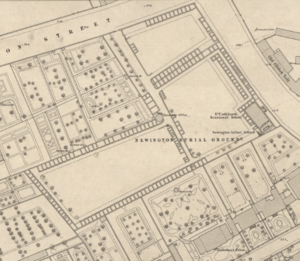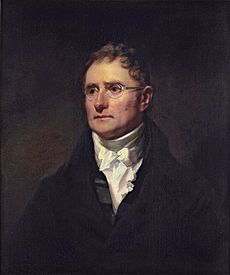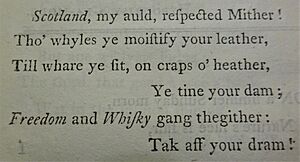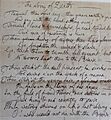Jean Lorimer facts for kids
Quick facts for kids
Jean Lorimer
|
|
|---|---|
| Born | 1775 Craigieburn, Moffat parish
|
| Died | 1831 Newington, Edinburgh
|
| Occupation | Governess and housekeeper |
Jean Lorimer (1775–1831) was a close friend of the famous Scottish poet Robert Burns. He often called her his "Lassie wi' the lint-white locks" (which means 'girl with flax-white hair') or "Chloris" in his poems. Jean was born at Craigieburn House near Moffat. From 1788 to 1791, she lived near Burns when he was at Ellisland Farm. Her family's farm, Kemmishall, was just two miles from his.
Burns wrote many songs for Jean. He once wrote that she was "one of the finest women in Scotland." They first met when Jean was a teenager. Burns was working as an excise officer, which meant he visited farms like hers.
Contents
Jean Lorimer's Early Life and Family
Jean's father, William Lorimer, was a merchant who sold tea and wine. He was also a farmer. Her mother was Agnes Carson. They got married in 1772.
In 1790, Jean's parents started farming at Kemmishall Farm. This farm was close to Ellisland, where Robert Burns lived. Jean became good friends with Jean Armour, who was Robert Burns's wife. Burns often visited their home.
Jean had one sister and three brothers. She was known for being very pretty. She had blue eyes and fair hair, which was unusual in that area. Jean also had a lovely singing voice. Many young men noticed her.
Jean's Marriage and Challenges
When Jean was about 18, she married Andrew Whelpdale. He was 19 and from Penrith. They went to Gretna Green to get married. This was a place where young couples could marry quickly.
However, Andrew left her just a few weeks later. He went back to his home to avoid people he owed money to. Jean had to return to her parents' farm. She started using her maiden name again. But she was still legally married to Andrew.
Years later, Jean visited Andrew in a debtors' prison. This was a jail for people who couldn't pay their debts. She visited him every day for a month.
In 1795, Jean's family moved to Dumfries. Her father's business was not doing well. Robert Burns remained a good friend to the Lorimer family. He wrote a letter saying he wanted to see Jean and her family.
Jean later moved to northern England. She worked as a governess, teaching children in different families. In 1822, she returned to Scotland and continued working as a governess.
Towards the end of her life, Jean worked as a housekeeper in Edinburgh. When she became too unwell to work, she was given a small flat. She lived there for the rest of her life.
Jean Lorimer passed away in September 1831 at age 56. She was buried in the Preston Street Burial Ground in Edinburgh. Her gravestone has a special message. It says she was the "Chloris" and "Lassie wi' the lint white locks" of Robert Burns.
Jean Lorimer and Robert Burns's Friendship
Robert Burns wrote about two dozen songs for Jean. He called her 'Chloris' in many of them. 'Chloris' was a name from old Greek stories. It meant the goddess of spring and flowers. Burns said that Chloris was the "lovely goddess of my inspiration."
In 1791, Burns wrote some songs for his friend, John Gillespie. John was also an excise officer. One song was "Sweet Closes the Ev'ning on Craigieburn Wood." Burns hinted that Jean had feelings for John.
Burns and Jean Armour often invited Jean Lorimer to visit. In August 1795, Burns wrote that his wife would ask Jean to come over. At one gathering, Jean Armour sang a song inspired by Jean Lorimer. It was called "O, that's the lassie o' my heart."
Burns used the names 'Jean' or 'Chloris' in his songs from 1794. He saw her as a special person for his songs. He wrote that he would admire a beautiful woman to help him write verses. He said her eyes were like lightning and her smile was divine.
Burns asked a music publisher, George Thomson, for a copy of his book Select Scottish Airs for Jean. He wrote that Jean was proud to be featured in the collection. Burns was also proud to please her.
In 1796, Burns wrote that he didn't like using the name 'Chloris' anymore. He felt it was strange to use a Greek name in a Scottish song.
Many people believe that Burns and Jean were just good friends. The songs he wrote for her do not show deep romantic feelings. This suggests their friendship was not romantic.
Jean's Keepsakes of Burns
On August 3, 1795, Burns gave Jean a copy of his poems. It was the last edition published during his lifetime. He wrote a special message inside the book. He called it a "friendship's pledge."
A writer named James Hogg said that Jean kept a lock of Burns's hair. She kept it in a small box.
Songs Dedicated to Jean Lorimer
Burns wrote more songs about Jean Lorimer than any other woman. His last song for her, "Yon rosy brier," was written in January 1795. Sometimes, Burns would change a song to be about a different person.
Jean even helped with some of the songs. She asked for changes to lines in "Whistle and I'll come to ye, my lad."
Here are some of the songs Burns wrote for or about Jean Lorimer:
- Craigieburn Wood (1791, 1794)
- O Poortith cauld and restless love (1793)
- Come, let me take thee to my breast (1793)
- Whistle and I'll come to ye, my lad (1793)
- She says she lo'es me best of a' (1794)
- On Chloris requesting me to give her a sprig of blossomed thorn (1795)
- Ah, Chloris, since it may na be (1793)
- How long and dreary is the night (1794)
- Let not women e'er complain (1794)
- The Lover's morning salute to his mistress (1794)
- Wilt thou be my dearie? (1793)
- Fair Jenny (1793)
- Behold, my love, how green the groves! (1794)
- It was the charming month of May (1794)
- Lassie wi' the lint-white locks (1794)
- I'll ay ca' in by yon town (1795)
- O wat ye wha's in yon town (1795)
- Address to the Woodlark (1795)
- The author, on hearing a Thrush sing in a morning walk (1793)
- Mark yonder pomp of Costly Fashion (1795)
- On Chloris being ill (1795)
- 'Twas na her bonie blue e'e (1795)
- Forlorn, my love, no comfort near (1795)
- Thine am I, my faithful Fair (1793)
- Why, why tell thy lover (1795)
- O' this is no my ain lassie (1795)
- Yon Rosy Brier (1795)
- O wha is she that lo'es me? (Uncertain)
- To Chloris (Inscription) (1795)
- Their Groves o' Green Myrtle (1795)
Images for kids










